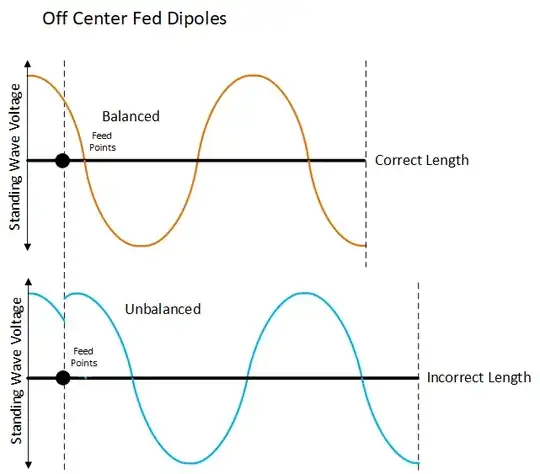Does a balun/choke have to "work harder" in an off-center fed dipole than when the feedpoint is at the center? Or do the standing waves that develop keep the antenna balanced electrically even if the physical feedpoint is driving unequal conductors? And if that's the case, does the situation change if the OFCD antenna is non-resonant (i.e. compared to the same length doublet when fed right in the middle)?
[And also to be clear, I'm not talking about a Windom/G5RV/etc. where a portion of "feedline" is intentionally incorporated into the antenna — assume any necessary balun/choke is incorporated directly at the feedpoint for the purposes of this question.]
We've touched on aspects of this through a few other Q&A's here but I'm not finding anything specific to the "balance" of an off-center feed:
- How does moving a feedpoint off-center in a dipole affect the resonant frequency and resistive load?
- How is impedance matching related to balance and common-mode currents?
- Understanding coax radiation and "current on the shield"
- VHF Balancing, necessary? Methods?
(And for full disclosure, this is admittedly closely related to my How to best ditch the counterpoise of a random wire antenna? question but seems sufficiently standalone to ask separately.)
Basically it's made me realize that my understanding of "balance" and why/when a balun is necessary is still pretty weak — I can imagine how in a simple resonant dipole fed right at the midpoint, a choke might still be have to "fix up" a bit of mismatch between the two halves especially due to real-world environment (nearby conductors, material/construction imperfections, etc.) to fully avoid current on the shield.
But with an off-center feed it seems that there's a great deal of (intentional) "mismatch" between the two sides of the antenna already while the design is still on paper. But yet we talk of the impedance "at the feedpoint", rather than the impedance "into the short side" distinct from "into the long side". Do the currents on the two sides of an off-center feed still naturally balance out despite their totally different lengths — at least as much as they would in any real-world environment? Or does the choke end up having to dissipate more and more current as the feedpoint moves closer to an end?
